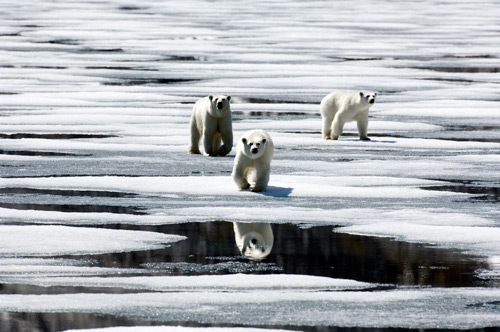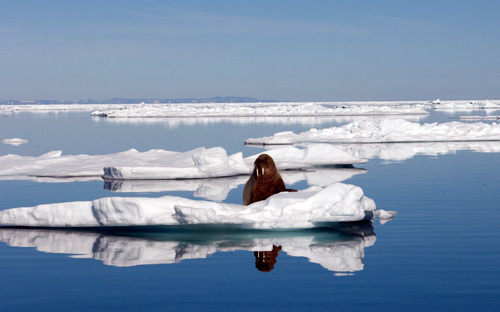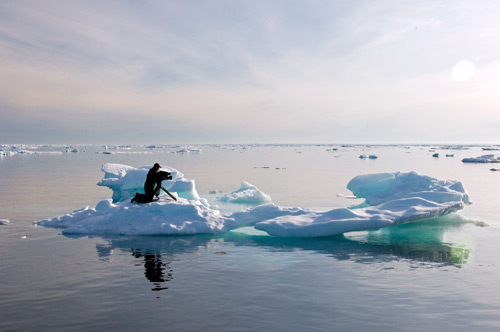Making the Connection: Ice Cover in the Arctic
By Jean-Michel Cousteau

It is widely accepted scientific knowledge that climate change has drastically accelerated rates of ice melt all over the planet, contributing to sea level rise. This is only part of the story, however. Like the visible part of an iceberg, it represents only a small part of the suite of processes and ecological changes now affecting polar seas, the global ocean system, and the entire planet. Ninety percent of the story remains hidden beneath the surface. Not appreciating the complexities and implications of these hidden factors can have dangerous consequences. Remember the Titanic? Viewing that historical event through the lens of the present inevitably leads us to wonder, “How could the captain and his crew allow the ship to collide after they were warned about the danger of icebergs? Why were they not paying closer attention to their surroundings?” The fact is they could not avoid the collision because they only saw, literally, ‘the tip of the iceberg’.
Today, we are less concerned with ships crashing into giant masses of ice and more focused on giant masses of ice crashing into the sea. However, we cannot afford to make the same mistake as the crew of the Titanic. We need to be aware of the obvious and superficial changes occurring in the arctic, as well as the hidden complications – the connections between seemingly unrelated human activities and the melting arctic. We need to remember that our wasteful use of fossil fuels, unchecked industries, and overexploitation of natural resources have been accelerating climate change since the Industrial Revolution.
During Ocean Future Society’s 2007 expedition to the Arctic to film beluga whales for our PBS special Sea Ghosts, we investigated the rapidly shrinking ice masses to find out how the phenomenon relates to the belugas and to us. What we discovered was shocking. 460,000 square miles (1,192,000 sq km) of ice was lost between 2005 and 2007 alone. Although the amount of ice present on Earth has increased and decreased throughout geologic time, recent scientific studies have revealed that the ice has been disappearing at unprecedented and alarming rates.

Since 2007, researchers have documented rates of glacial melting in the arctic. The National Oceanic and Atmospheric Administration’s 2008 data on surface melting notes that “the onset of melt progressed more quickly than in previous years, and melt ponds persisted longer and later than usual.” The United Nations’ Science Compendium 2009 reports that a 2.5 mile wide (4km- wide) expanse of water that formed in 2006 completely drained into the icy depths in 90 minutes, at a flow rate greater than Niagara Falls.” Summer ‘melt lakes’ found on the ice sheets are large enough to be seen from space and drain like giant bathtubs. The lake water percolates through the ice and settles in between the ice sheet and the land underneath. In the same way water lubricates plastic so we can fly down a Slip and Slide, it lubricates the interface between land and ice so ice sheets can slide more easily and more rapidly downhill toward the ocean. Both the melt water and glacial ice that slides from land to the sea contribute to the sea level rise we are now witnessing worldwide.
Interestingly, in Science Compendium 2009, scientists also report that something is causing ocean-bound glaciers to melt more quickly than ‘land-terminating’ glaciers, but do not seem to have found an explanation for this occurrence. The United Nations Climate Change Statistics report warns, “Paleoclimate information supports the interpretation that the warmth of the last half century is unusual in at least the previous 1,300 years. The last time the polar regions were significantly warmer than present for an extended period (about 125,000 years ago), reductions in polar ice volume led to 13 to 20 feet (4-6m) of sea level rise.” Sea level rises as polar ice sheets melt and because increased temperatures cause seawater to expand.

The National Climatic Data Center reports that March 2011 marks the 18th consecutive March and the 118th consecutive month with below average Arctic sea ice extent. However, recent years do seem to show a break in the trend. Satellite data and images from the National Snow and Ice Data Center show that there was more arctic sea ice cover in 2008, 2009 and 2010 than there was in 2007. The Ocean Futures Society is pleased to see this reprieve, contrary to what was previously predicted. Unfortunately, with more and more greenhouse gases being released into the atmosphere daily, the processes set in motion are likely to continue until we take serious action to reduce these emissions. It is vital that we use this time wisely to mitigate the impacts of our lifestyles on the ocean and earth by living as sustainably as possible. Because our consumption of energy and natural resources is clearly connected to the state of the arctic, making responsible daily choices regarding energy use, transportation, and nutrition is as important as the research being done to inform us of the effect of our choices.
As divers, we have a responsibility to share our personal experiences of adventures underwater and of the hidden treasures we discover on every dive. As well, we must continually educate ourselves on how we can turn these experiences into responsible lifestyle choices that best protect our blue planet for our enjoyment today and for all future scuba divers who will follow in our fin kicks.







